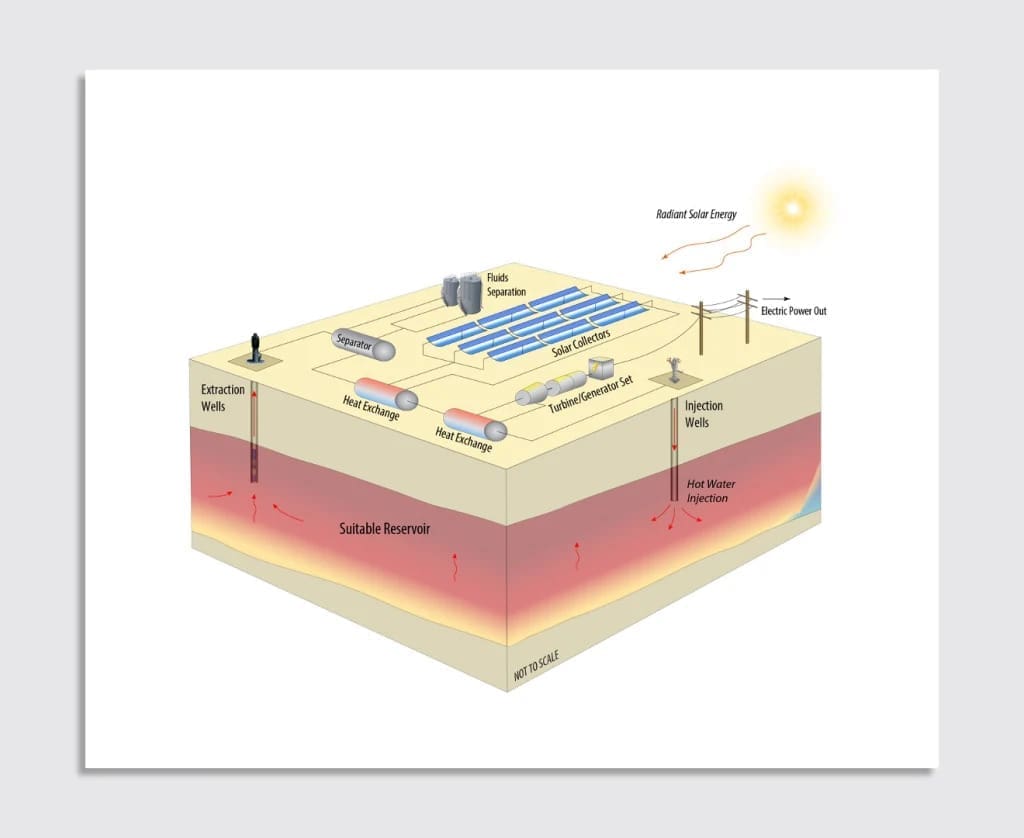When a small company leased an oil field in California’s Central Valley six years ago, it quickly realized that drilling for oil wasn’t going to be viable. As the state works to decarbonize, it was nearly impossible to get permits.
But the team discovered that it could use old oil wells for a different purpose: storing solar power. Renewable energy can be stored as heat in underground reservoirs, and then used to generate electricity when the grid needs a boost. Unlike lithium-ion batteries, the process can cheaply store renewable energy for more than a month.
“In 2020, we said, well, we just need to focus exclusively on geological thermal energy storage, and forget about oil production,” says Mike Umbro, a partner at the company, called Premier Resource Management.
HOW GEOLOGICAL THERMAL ENERGY STORAGE WORKS
To store energy, the system will use mirrors to concentrate sunlight and heat up fluid flowing through a loop above the ground, bringing the temperature to 700 degrees Fahrenheit. Then brackish water inside a depleted oil well will be pumped up, heated through a heat exchanger, and sent back underground. (The brackish water is already inside the wells; the energy storage process actually makes it cleaner.)
When the grid needs more power—at night, or on a cloudy day when there isn’t much solar power produced—the heat can be used to run a steam turbine power generator, and send power out through transmission lines.

The basic components of the technology, called “GeoTES” or geological thermal energy storage, are already proven. “It really doesn’t require any kind of scientific breakthrough, not like new batteries,” says Guangdong Zhu, a senior researcher at the National Renewable Energy Laboratory (NREL), which is partnering with the company as it plans a pilot project. (The company is also working with Berkeley National Lab and Idaho National Lab, along with a technology partner, Ramsgate Engineering.)
The loop circulates continuously, adding heat whenever the sun is shining. But it can keep sending power to the grid for long stretches even when it’s cloudy. The system could provide power for as long as 42 days before it needs to recharge, the company says.
In the winter, when California can be rainy or cloudy for long stretches of time, it could be a critical way to keep the state running on clean power. The grid already uses lithium-ion batteries to store energy, but that’s only economical for storing power over short periods, not weeks. Last winter, Umbro says, the batteries that are now on the grid weren’t always able to recharge because of the weather. Utilities had to turn to natural gas plants, and gas prices spiked.
WHY OLD OIL WELLS ARE A GOOD FIT
Geological thermal energy storage can take other forms as well—NREL is also working with a company in Texas on a pilot project that will store excess renewable energy in reservoirs that were never used for oil and gas. But oil wells are a particularly good fit because the oil industry already has ample data about what’s underground. “You can significantly reduce your exploration risk because we know that we have a suitable reservoir to work with,” says Umbro.
Across the country, there are an estimated 4 million abandoned oil wells. They aren’t all suited for the approach that Premier is taking; the location needs to get enough sun, be near transmission lines, and the reservoirs themselves need to have certain geological characteristics. It should also be far from homes so there’s no chance that groundwater could be affected as the system runs. Still, a large number of old wells could be converted, particularly in the Southwest. And that could play a big role in helping grids reach goals to run solely on renewable energy.
“In the west side of the San Joaquin Valley alone, we believe there’s potential to install at least 60 gigawatts,” says Umbro. The oil field where the company plans to build its pilot, roughly an hour west of Bakersfield, is surrounded by a sea of large black oil pumps. Umbro notes that the new equipment will be low to the ground and less of an eyesore. The company is also doing environmental remediation work on the land that might not have happened otherwise. Reusing the land also means that the technology doesn’t need to encroach on nature.
“You’re taking land that is already disturbed, that’s already been drilled, that’s already been developed, and converting it to a clean energy system rather than a fossil energy system,” he says.
HOW THE TECH COULD HELP THE OIL INDUSTRY CHANGE COURSE
The company is still working through the yearslong process of getting permits for its pilot project, but it hopes to begin the demonstration in 2026 or 2027. If the pilot works as expected, the company plans to expand to a much larger 400-megawatt storage system, at a cost of $2 billion. That system could power all 300,000 homes in Bakersfield. The company estimates that it could avoid more than half a million metric tons of CO2 emissions a year by replacing the need to run fossil fuel power plants when demand spikes.
The approach could bring back jobs for former oil industry workers. “Kern county, particularly where we’re developing the project, is a disadvantaged community,” Umbro says. “Our workers in oil and gas are losing their jobs as oil and gas is phased out of our state.” The new technology needs workers to do the same type of work, he says, “so you don’t have to tell someone, “Hey, we’re going to transition you and you’re going to relearn something new.’” The project will likely create 200 to 400 construction jobs, lasting as long as a decade, and around 100 ongoing jobs. If other oil companies copy the idea, it would create more jobs in the area.
“You can decarbonize our energy systems in California with an energy renaissance, and technologies that are going to transform legacy fossil assets into clean assets,” says Umbro. “I think that’s what the industry needs to focus on: what the future looks like.”
Source: www.fastcompany.com





